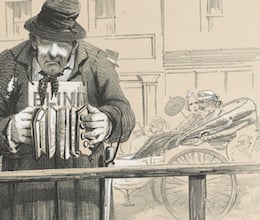S.T. Gill
Samuel Thomas Gill, known as S.T. Gill, came to Australia with his family in 1839 at the age of 21, settling in South Australia. He became one of the best known artists of the gold rush era, depicting the daily lives of diggers on the gold fields.
Soon after he arrived, Gill found he could make a living by painting portraits of people, animals and scenery. He would even make house calls to paint a pet or family member at no extra charge.
In 1846, following the promise of adventure, Gill joined an expedition led by John Horrocks to explore the arid centre of South Australia. One of Gill's paintings from the expedition was an illustration of the first camel brought to Australia. Camels became an important part of Australian land exploration as each camel could carry over 150 kilos and needed little water to survive.
Sadly the expedition ended soon after it began, when Horricks was accidentally shot due to a bad-tempered camel. He died from his wounds, but Gill went on to continue his travels in Victoria and New South Wales.
By early 1852, Gill had made his way to the Victorian goldfields. He spent four years recording the experiences of diggers and their families through his art. Gill produced detailed illustrations of gold mining techniques and daily life including boxing matches, restaurants, butchers and 'sly grog' tents selling alcohol illegally.
But Gill wasn't afraid to depict the darker side of life on the goldfields. He created works that showed racial tension between local diggers and Chinese and Indigenous people, the environmental impact of mining and the many people who came to the goldfields hoping for riches only to find terrible living conditions and often death.
Gill sold many copies of his gold rush sketches and watercolours as small lithograph booklets, much like modern postcards. As a result he became one of the best known and popular Australian colonial artists of the time.
In 1856, Gill left the goldfields to move to Sydney but by 1864 he had returned to Melbourne for good.
Sadly, the Melbourne that Gill found was not the one that he had left behind. His art had always been known for its honesty - it showed life as it was, however good or bad. By the late 19th century, the public preferred decorative, nostalgic images without the social conscience or realism that had made Gill a household name in the 1850s.
Gill still spent the last years of his life painting, but could no longer make a living from his art. Even though he created some of his most important work during this time, including Doing the Block, he died on the steps of the Melbourne GPO building in 1880, poor and alone, with noone but his dogs for company.
S.T. Gill was an important colonial artist who created some of the most vivid images we have of day-to-day life on the goldfields.








